Curaçao
Imagine a vibrant tapestry of colors where the iridescent blue of the Caribbean Sea meets the sun-kissed shores of Curaçao. Travel to Curaçao and find yourself entranced by its storied cobblestone streets lined with Dutch colonial architecture, each house painted in bold, radiant hues that mirror the stunning sunsets. As you wander through the bustling markets, the rich aroma of spiced street food tantalizes your senses, promising new culinary adventures with every bite. The rhythmic beats of local music fill the air, a melodious invitation echoing from the island's hidden corners. Plunge into the crystalline waters, where schools of dazzling fish dance among coral reefs, painting an underwater wonderland you won't soon forget. The gentle trade winds whisper tales of the island’s diverse heritage, beckoning explorers and dreamers alike. Travel to Curaçao and immerse yourself in a world where every moment is steeped in magic, promising memories that will beckon you to return again and again.
Curaçao Travel Season
Travel enthusiasts often find themselves captivated by the enchanting island of Curaçao, nestled in the Caribbean. Travel to Curaçao offers a unique blend of Dutch heritage, vibrant culture, and stunning natural beauty. When planning a trip to this paradise, it's important to understand the best times to visit for an optimal experience. Curaçao is renowned for its year-round warm climate, making it an inviting destination at any time. However, subtle variations in weather, tourist influx, and local festivities play crucial roles in defining the most suitable travel season.
The peak travel season in Curaçao typically spans from mid-December to mid-April. During this time, visitors are greeted with perfectly sunny skies and temperatures averaging in the mid-80s Fahrenheit (around 29°C). The demand during this period is high, primarily due to the influx of travelers escaping the winter cold from North America and Europe. As a result, visitors can expect bustling resorts and popular beaches teeming with activity. However, traveling during this season ensures access to a full lineup of activities and events, such as carnival celebrations in February—an explosion of color, music, and parades that capture the island’s vibrant culture.
Those seeking a more tranquil experience might consider traveling to Curaçao during the shoulder seasons. These periods, from late April to early June and September to early December, provide a sweet spot for visitors seeking favorable weather with fewer crowds. The temperatures remain consistently warm, hovering around the high 70s to low 80s Fahrenheit (25-28°C), with occasional refreshing breezes. Travel to Curaçao during this time allows visitors to explore the island’s attractions, like the UNESCO-listed historic center of Willemstad or the picturesque diving sites, without the hassle of long queues. Additionally, accommodation prices tend to be lower, and availability is better.
Travel to Curaçao in the offseason, primarily from June to August, has its unique draws. Although this period is designated the rainy season, the island typically experiences brief and sporadic showers, often in the late afternoon or evening. The lush landscape is rejuvenated during these months, painting a verdant backdrop for those traveling to Curaçao. Moreover, this season sees the celebration of Dia di Bandera in July, a national holiday filled with local music, dance, and artifacts that offer a glimpse into Curaçao’s rich traditions.
Families traveling to Curaçao will find the shoulder and off-peak seasons especially appealing, as attractions like the Curaçao Sea Aquarium and the numerous child-friendly beaches are less crowded. Experienced travelers also appreciate the perks of exploring local markets and dining spots at a leisurely pace. The warm hospitality of Curaçao’s locals, or “Curaçaoans,” shines more vividly when there are fewer tourists, providing more opportunities for authentic cultural exchanges.
Regardless of when you decide to travel to Curaçao, this island promises an unforgettable experience. From its crystalline beaches and rich marine life to its lively cultural festivities and historical architecture, Curaçao has something to offer everyone. Being aware of the subtle changes across seasons enables travelers to tailor their itinerary for a memorable journey.
The Weather and Seasons in Curaçao
Travel to Curaçao and experience its delightful tropical savanna climate, characterized by warmth and sunshine year-round. Nestled in the Southern Caribbean, just off the coast of Venezuela, Curaçao offers a unique climate that appeals to travelers seeking a sunny paradise. With an average temperature hovering around 84°F (29°C), Curaçao is a destination that promises pleasant warmth and minimal extreme weather changes.
While Caribbean islands are often associated with defined wet and dry seasons, Curaçao's climate is relatively consistent, with subtle seasonal variations. The island experiences a less pronounced rainy season spanning from October to February. During this time, travelers may encounter short-lived showers, usually occurring in the evenings or at night. Rainfall averages around 22 inches (558 mm) annually, with November being the wettest month. Nonetheless, rain showers are typically brief, preserving the island's allure for outdoor activities.
Temperature and Humidity
The temperature in Curaçao remains consistently warm, rarely dropping below 77°F (25°C) or exceeding 92°F (33°C) throughout the year. This constant warmth makes travel to Curaçao appealing, as visitors can expect beach-friendly weather at almost any time of year. Humidity levels remain manageable due to the island's steady northeastern trade winds, providing a cooling effect that enhances comfort, even during the warmer months.
Windy Months and Travel Recommendations
Curaçao's position outside the hurricane belt provides an advantage for travelers worried about storm seasons. The period from January to September tends to be windier, especially from February to May. These windy months are favored by water sports enthusiasts, particularly windsurfers and kiteboarders, due to the ideal windy conditions. This period is also suitable for visitors who prefer less humidity and slightly cooler evenings.
The Most Favorable Time for Travel to Curaçao
The most favorable time to travel to Curaçao is during the dry season, from March to June, when rainfall is minimal and sunshine is plentiful. The island is bustling with activities and vibrant local events, such as the annual Carnival in February, known for its lively parades and cultural festivities. Travelers during this period can enjoy Curaçao at its best—dry weather, vibrant cultural displays, and the beauty of the island's beaches and waters.
Overall, Curaçao's reliable weather patterns and its strategic location outside the hurricane belt make it an inviting destination for travelers year-round. The combination of friendly temperatures, refreshing trade winds, and the island's rich cultural events ensures that those who travel to Curaçao are met with an unforgettable Caribbean experience.
Accepted Payment Methods and Other Payment Information in Curaçao
When planning to travel to Curaçao, understanding the various payment options available can enhance your travel experience. The official currency of Curaçao is the Netherlands Antillean Guilder (ANG), also known as the Florin. However, the US Dollar is widely accepted across the island, making it convenient for travelers to navigate their expenses without constantly exchanging currencies.
For travel to Curaçao, credit cards are a popular and convenient choice, with Visa and Mastercard being the most commonly accepted across hotels, restaurants, and major retail outlets. American Express is also accepted, though not as universally as Visa and Mastercard. Discover card users may find limitations in acceptance, so it's advisable to carry a backup payment method. Small businesses and local establishments may still prefer cash payments, so having some local currency or US Dollars on hand is beneficial.
While traveling to Curaçao, cash remains an essential form of payment, particularly in smaller towns, at local markets, and for services like taxis. ATMs are readily available for withdrawing cash in both guilders and US Dollars, although fees can apply, especially for international transactions. It's a good practice to notify your bank before traveling to avoid any issues with withdrawing money abroad.
When it comes to tipping etiquette on your travel to Curaçao, it is customary to leave a tip of around 10-15% at restaurants, which is sometimes included in the bill as a service charge. For other services, like taxi drivers and hotel staff, small tips are appreciated but not obligatory. Be sure to check if a service fee has already been added to your bill to avoid tipping twice.
As you travel to Curaçao, it's helpful to note that the island's vibrant tourism industry makes it easy and relatively hassle-free to pay for activities, dining, and accommodations. However, having a mix of payment options can provide flexibility and peace of mind during your Curaçao adventure. This beautiful island caters to a variety of payment preferences, making it easier for tourists to enjoy all that Curaçao has to offer without facing financial inconveniences.
Why You Should Travel to Curaçao
Travel to Curaçao and experience a colorful Caribbean gem that promises unique and unforgettable adventures. This island is a vibrant blend of cultural richness, stunning natural beauty, and thrilling activities catering to a diverse range of travelers. Travel enthusiasts from across the globe are drawn to Curaçao for its distinct charm and warm hospitality, distinguishing it from other Caribbean destinations.
Vibrant Willemstad and Its Dutch Colonial Architecture
Curaçao's capital, Willemstad, is renowned for its vividly colored colonial buildings, a testament to the island's Dutch heritage. The city's architecture, characterized by iconic pastel hues, is a UNESCO World Heritage Site. Visitors who travel to Curaçao are enchanted by the floating Queen Emma Bridge, which offers splendid views of the historic waterfront. Wandering through Willemstad's cobblestone streets reveals charming boutiques, cafes, and museums that celebrate Curaçao’s history.
Pristine Beaches with Turquoise Waters
Curaçao is home to some of the most breathtaking beaches in the Caribbean. Playa Knip, Cas Abao, and Jan Thiel Beach boast crystal-clear waters and soft sands, inviting visitors to relax or engage in various water sports. Whether you're interested in snorkeling, scuba diving, or simply sunbathing, these beaches offer a perfect backdrop for a rejuvenating travel experience.
A Scuba Diver's Paradise
For diving enthusiasts, travel to Curaçao offers access to some of the world's most spectacular underwater landscapes. Dive sites such as Superior Producer and Tugboat offer rich marine life, including vibrant coral reefs, colorful fish, and intriguing shipwrecks. The island's clear waters provide excellent visibility, making it a premier destination for both novice and experienced divers.
Diverse Cultural Experiences and Heritage
Curaçao is a melting pot of cultures, including African, European, and Caribbean influences. Visitors can explore this rich tapestry through music, art, and culinary experiences. The island's diverse heritage is celebrated in festivals like the Curaçao Carnival, where lively parades and infectious rhythms showcase local traditions.
Endless Outdoor Adventures
Travelers seeking adventure will find plenty of exhilarating activities in Curaçao. From exploring the island's rugged terrain with an ATV tour to hiking Christoffel National Park, nature enthusiasts will enjoy the diverse landscapes. Kite-surfing and windsurfing are also popular, thanks to the island's steady trade winds, offering an adrenaline rush against a stunning coastal backdrop.
Flora and Fauna: A Nature Lover’s Haven
Aside from its beaches, Curaçao's natural beauty includes unique ecosystems like Hato Caves, where stalactites and stalagmites reveal the island's geological past. The salt flats and flamingo-strewn areas are perfect for birdwatching. This rich biodiversity makes travel to Curaçao an ideal option for eco-tourists and naturalists alike, offering a distinctive Caribbean ecotourism experience.
Delectable Culinary Scene
Curaçao’s cuisine is a delightful blend of cultures, offering dishes such as Keshi Yena, a traditional cheese-filled entrée, and arepas influenced by the island's Venezuelan neighbors. Gourmet travelers can indulge in a wide array of flavors at local eateries and upscale restaurants, making culinary adventures in Curaçao unforgettable.
Rich History from Maritime to Modern Times
Travel to Curaçao provides an opportunity to delve into an intriguing history, from the island's era of colonization and piracy to its current status as a leading trade hub. Museums such as the Museum Kura Hulanda document this captivating past, shedding light on slave trade history and the island's cultural evolution, making it an insightful visit for history enthusiasts.
Lively Nightlife and Entertainment
Curaçao offers a vibrant nightlife scene, with beachfront bars, clubs, and lively events that keep the party going into the early hours. Whether you prefer dancing under the stars to calypso tunes or indulging in a relaxing evening with live jazz, Curaçao's entertainment options promise an enjoyable night out for every traveler.
Welcoming Local Hospitality and Warm Climate
One of the most compelling reasons to travel to Curaçao is its friendly and welcoming people. The island's multicultural community is known for its warmth and hospitality, making guests feel at home. Coupled with Curaçao's sunny climate, with consistently warm temperatures year-round, visitors are assured of a pleasant and inviting atmosphere, ensuring a memorable travel experience.
The History of Curaçao
Curaçao, a jewel in the Caribbean Sea, has a rich blend of cultural influences and a compelling history that seduces history lovers time and again. Its story begins with the indigenous Arawak and Caquetio tribes, who inhabited the island long before European explorers set their sights on the New World. The Spanish arrived in 1499, led by Alonso de Ojeda, and Curaçao soon became part of Spain's expansive empire. However, it was not until the Dutch West India Company seized control in 1634 that Curaçao's significant strategic importance was realized. The island became a thriving hub of trade and commerce, especially in salt and the slave trade. Over time, this vibrant interchange of cultures helped lay the foundations for today's multicultural tapestry, making travel to Curaçao a fascinating journey through time.
Curaçao's remarkable architecture is one of its most endearing legacies, with the capital city, Willemstad, boasting an array of colorful colonial buildings that echo its storied past. The city is a UNESCO World Heritage site, a testament to its historical and cultural significance. Landmarks such as Fort Amsterdam, the Queen Emma Bridge, and the Mikvé Israel-Emanuel Synagogue, which is the oldest surviving synagogue in the Americas, offer glimpses into Curaçao's colonial history and Jewish heritage. These sites are not just relics of the past; they are living connections to the diverse narratives that have shaped the island. Traveling to Curaçao thus offers a chance to walk through history, exploring the outstanding cultural landmarks that have withstood the test of time.
The robust Afro-Caribbean influence on Curaçao's culture is also notable for those who travel to Curaçao seeking to understand its unique character. The island's involvement in the transatlantic slave trade left an indelible mark on its cultural and social identity. The descendants of enslaved Africans have significantly shaped the island’s culture, particularly through language, music, and cuisine. The creole language Papiamentu, a blend of African, Spanish, Dutch, and Portuguese influences, is a unique cultural identifier. Celebrations like the Tumba Festival, a vibrant music festival, and the colorful Carnival, an exuberant parade and party, showcase the island's rich African roots. These cultural expressions are not only entertaining but are also profound reminders of the island's complex history, offering a deeper understanding for those who travel to Curaçao.
Today, Curaçao stands as a symbol of resilience and cultural integration, its historical and modern influences seamlessly intertwined to create an attractive destination for history enthusiasts and cultural tourists alike. The island's contemporary identity has been shaped by its past as well as by innovations in infrastructure, economic diversification, and social progress. While Curaçao maintains its historical charm, it also embraces modernity with luxury resorts, vibrant nightlife, and a burgeoning art scene. This distinctive fusion invites travelers to explore not just a place, but a living narrative of culture and history, encouraging more people to travel to Curaçao and discover its multifaceted appeal. Whether you're strolling through the historic streets of Willemstad or diving into the island's dynamic cultural scene, Curaçao promises an enriching experience that captivates all who journey there.
The Culture of Curaçao
Curaçao, an intriguing gem nestled in the southern Caribbean Sea, boasts a vibrant cultural tapestry woven from its diverse ethnic roots, colonial history, and Afro-Caribbean influence. When you travel to Curaçao, you'll witness a harmonious blend of cultures, predominately shaped by African, Dutch, and Latin American traditions. This multicultural island is exemplified through its language, with Papiamento—an enticing mix of Spanish, Portuguese, Dutch, and African languages—as the local vernacular. Curaçao stands out as a cultural melting pot where traditions from different continents intersect, creating a unique and inviting atmosphere for all who visit.
One of the island’s most captivating attractions is its lively festivals and annual celebrations. Travel to Curaçao to experience the grandeur of Carnival, a vibrant display of music, dance, and pageantry that sweeps the island each year. Drawing parallels with the famous Carnivals of Brazil, Curaçao’s celebration features colorful parades, mesmerizing costumes, and infectious rhythms, infused with a distinctly Caribbean flair. Moreover, the island recognizes a multitude of cultural and religious festivals, showcasing its rich array of influences. From the harvest festival of Seú to the light-hearted traditions of Día di Bandera, each event embodies the spirit and resilience of the island’s people.
Curaçao's daily customs and lifestyle offer travelers an authentic glimpse into its cultural heartbeat. Daily life on the island often revolves around social gatherings and communal experiences, where music and dance play a pivotal role. Locals are adept at culinary arts, with seafood-inspired dishes and unique flavors stemming from the island’s cultural amalgamation. When travelers venture to Curaçao, they are invited to partake in the island's vibrant culinary scene, savoring dishes like Keshi Yena and Kabritu Stoba, which highlight Curaçao’s Creole influence and local ingredients. The island's hospitality culture ensures that visitors feel at home, making their travel to Curaçao a fulfilling experience.
Cultural expressions in art, music, and dance are integral to the identity of Curaçao. Traditional music genres such as Tumba and Tambú are hallmarks of the island, resonating with the soulful echoes of its Afro-Caribbean roots. The island is also home to a thriving arts scene, with numerous galleries and art festivals showcasing local talents. Murals adorn the streets, exemplifying the vibrant spirit and creativity of the Curaçaoan people. Amidst modernization, there is a steadfast dedication to cultural preservation, with initiatives aimed at safeguarding the island's indigenous heritage and fostering traditional skills and crafts. When you travel to Curaçao, you immerse yourself in a lively cultural landscape that promises an enriching and unforgettable journey.
The Culinary Experience of Curaçao
When you travel to Curaçao, you embark on a journey that delights not only your senses with vibrant colors and inviting beaches but also your palate with a rich tapestry of flavors. Curaçao's culinary repertoire is a celebration of its multicultural heritage, blending African, Caribbean, Latin American, and European influences. Travelers can indulge in traditional Curaçao dishes such as "keshi yena," a savory delight where cheese is stuffed with spiced meat, vegetables, and sometimes dried fruits. This fusion of flavors mirrors the island’s melting pot of cultures, offering an authentic taste of Curaçao’s vibrant local life.
Another essential dish to try when you travel to Curaçao is "stobá," a slow-cooked stew typically made with beef, goat, or conch, simmered to perfection with spices and local vegetables. Accompany your meal with "funchi," a polenta-like comforting side made from cornmeal, or enjoy the delightful crunch of “pastechi,” pastries filled with cheese, meat, or even seafood. The street food scene in Curaçao is bustling with these local favorites, offering travelers an opportunity to savor the cuisine in a more casual setting, perhaps at one of the vibrant neighborhood markets where the aroma of sizzling foods fills the air.
Beverages in Curaçao add a refreshing touch to the culinary voyage, with famous offerings like the iconic Blue Curaçao liqueur, which infuses cocktails with a citrusy zing and a mesmerising blue hue. Travelers can also explore local craft brews, such as "Amstel Bright," a smooth beer that perfectly complements the island's warm climate. Wine enthusiasts will find a diverse selection of Caribbean and Latin American wines at many fine dining establishments, reflecting the island’s appreciation for international flavors. Additionally, there are specialty bars and cafés offering "batidos," fresh fruit shakes, to quench your thirst as you explore the island.
The culinary adventure in Curaçao is not limited to traditional and local flavors. The island’s dining scene caters to various dietary preferences and needs, including vegan and vegetarian options, with many restaurants offering innovative plant-based dishes that showcase the island's abundance of fresh produce. Throughout the year, food festivals celebrate Curaçao’s culinary diversity and innovation. Visitors traveling to Curaçao might time their visit to coincide with the annual "Curaçao Culinair," a vibrant food festival where top chefs present their creative takes on local and international cuisine, accompanied by live music and cultural performances. Whether savoring the flavors at a seaside shack, a bustling market, or a top-tier restaurant, dining in Curaçao is a journey through the heart and soul of this enchanting island.
What to See and Do in Curaçao
Curacao, with its vibrant culture, stunning beaches, and rich history, is a dream destination for travelers seeking a unique Caribbean escape. When you travel to Curaçao, there are endless experiences waiting to be explored. Here are some must-see and must-do activities that every traveler should consider on their visit to this beautiful island.
Discover the Enchanting Willemstad
A stroll through the colorful streets of Willemstad offers a vibrant introduction to Curaçao's cultural tapestry. This UNESCO World Heritage site boasts a rich blend of Dutch architecture, lively street art, and bustling markets. Families will enjoy the floating market where vendors sell fresh produce and catch from Venezuelan boats. Meanwhile, solo travelers can lose themselves in the quaint alleys lined with boutique shops and cozy cafes, soaking in the vibrant energy of this historical city.
Explore the Underwater Paradise
Curaçao is renowned for its crystal-clear waters teeming with marine life, making it a haven for scuba divers and snorkelers. The pristine reefs of the Curaçao Underwater Marine Park are home to exotic fish, vibrant corals, and intriguing shipwrecks. Beginners can start their underwater journey at Tugboat Beach while seasoned divers might prefer the deeper waters around the Superior Producer wreck. Adventure seekers will revel in the diverse underwater landscapes that make travel to Curaçao unforgettable.
Relax at the Breathtaking Playa Knip
Nestled on the northwestern coast of the island, Playa Knip is a picturesque beach that offers the quintessential Caribbean experience. This stunning locale, with its azure waters and soft sand, is perfect for families looking to spend a day splashing around and sunbathing. The beach is also great for snorkeling, as the clear waters provide an excellent view of the vibrant underwater ecosystems. Bring along a picnic and enjoy the serene beauty of one of Curaçao's finest beaches.
Sample Local Flavors at Old Market
For a taste of authentic Curaçaoan cuisine, head to the Old Market in Punda, where local chefs serve dishes steeped in tradition. Try the stobá, a hearty local stew, or savor the flavors of freshly caught fish seasoned with local spices. This bustling food court is the perfect spot for solo travelers and food enthusiasts eager to try something new. It's a savory adventure that captures the essence of Curaçao’s culinary scene.
Venture into the Christoffel National Park
For those who crave nature and adventure, Christoffel National Park offers lush landscapes filled with diverse flora and fauna. Hike up Mount Christoffel, the island's highest peak, for a panoramic view of Curaçao's rugged beauty. Birdwatchers will be in their element, spotting rare native species in their natural habitat. It's an invigorating experience that showcases the island’s natural splendor beyond its inviting beaches.
Embark on a Cultural Journey at the Curaçao Museum
The Curaçao Museum in Willemstad is an enlightening experience for history buffs and curious travelers alike. The museum not only showcases an impressive collection of art and artifacts but also provides insights into the island's colonial past and cultural evolution. Families and solo travelers can immerse themselves in the educational exhibits, offering a deeper understanding of Curaçao's rich heritage.
Dive into Local Art at Gallery Alma Blou
Art enthusiasts should not miss Gallery Alma Blou, a treasure trove of Curaçao's contemporary art and traditional crafts. Housed in a historic plantation house, the gallery provides a platform for local artists to exhibit their work. From vibrant paintings to intricate sculptures, the art here reflects the diverse cultural influences that shape Curaçao. It's a culturally enriching stop for those who appreciate the island's artistic expressions.
Experience the Thrill of Klein Curaçao
A day trip to Klein Curaçao, a small, uninhabited island off the southeastern coast, promises an adventure like no other. Accessible by boat, this isolated paradise offers pristine beaches and a perfect slice of tranquility. The expedition is ideal for adventurous travelers seeking an escape from the mainland, offering opportunities for snorkeling, exploring a shipwreck, and basking in the sun. Don’t forget to explore the old lighthouse for stunning views.
Take a Distillery Tour at the Curaçao Liqueur Factory
No trip to Curaçao would be complete without tasting the famous Blue Curaçao liqueur, and a tour of the Curaçao Liqueur Factory is a treat for the senses. Learn about the intriguing process of transforming the island's native laraha oranges into this iconic blue drink. Perfect for adults and those interested in the art of distillation, the tour includes tastings and insights into the liqueur's history. It's a delicious way to understand a unique aspect of Curaçao's culture.
Witness Wonders at the Hato Caves
A visit to the Hato Caves offers a mystical exploration of Curaçao's geological wonders. Formed from limestone coral millions of years ago, these caves feature stunning stalactites, stalagmites, and ancient petroglyphs. Guided tours reveal fascinating stories and legends surrounding these formations. An excellent educational experience for families and adventurers alike, the Hato Caves provide a captivating glimpse into the island's natural history.
Tips & Tricks for Traveling in Curaçao
Exploring the vibrant island of Curaçao requires some insightful pointers for a seamless adventure. When you "Travel to Curaçao," keep these tips in mind for an unforgettable experience.
Embrace Local Customs and Culture
"Travel to Curaçao" offers an opportunity to immerse yourself in the island's rich cultural tapestry. Curaçao's population is a blend of over 50 nationalities, which is reflected in its languages and customs. Attend a traditional Tumba music festival or savor the local cuisine such as Keshi Yena. Make sure to greet people politely with a smile; a simple “Bon dia” (Good morning) can go a long way in establishing good rapport with locals.
Utilize Public Transportation and Taxis
Exploring Curaçao does not necessitate renting a car, especially if you wish to avoid navigating unfamiliar roads. The island's public transportation is efficient, with buses and "Konvoois" (mini-vans) readily available for getting around. Taxis are also a practical option, and they can be a reliable way to travel if negotiating a fair fare in advance. This is particularly useful when traveling to Curaçao cities and beaches where parking can be limited.
Plan in the Off-Season to Avoid Crowds
To maximize enjoyment while minimizing crowds, consider "Traveling to Curaçao" during the off-season months between May and November. Not only are beaches less crowded, but accommodations may also be more affordable. The island’s climate remains warm and welcoming year-round, so you can enjoy sunbathing and swimming without the bustling high-season tourist influx.
Budget Travel Tips for Curaçao
"Travel to Curaçao" can be affordable with some strategic planning. Look for guesthouses or Airbnbs in residential areas for budget-friendly accommodations. Dining at local eateries, known as "snèks," offers a taste of local cuisine without straining your wallet. Additionally, many beaches are free to access, so you can enjoy the island's natural beauty without any extra cost.
Photographers' Paradise: Capture the Perfect Shot
Photographers will find Curaçao a mesmerizing canvas. For those traveling to Curaçao to capture its vibrant colors, get up early to photograph the pastel-colored Dutch architecture of Willemstad’s Handelskade during the soft morning light. Don’t miss the photogenic salt flats of Jan Kok and the flamingos in the countryside. Sunsets at Playa Kalki or Shete Boka National Park offer stunning vistas to close your day with dramatic shots.
Make the Most of Local Festivals
If your travel to Curaçao coincides with a local festival, seize the opportunity to participate. Carnival is celebrated with great enthusiasm and offers insight into the island’s artistic and creative spirit through elaborate costumes and parades. Engaging in these festivities provides a deeper appreciation of Curaçao’s vibrant culture and community spirit.
Understanding the Island’s Geography
When traveling to Curaçao, gaining a basic understanding of its geography will enhance your exploration. The island is long and narrow, with a rugged northern coastline and calm southern beaches. Punta Westpunt boasts more rugged landscapes, while the central and eastern regions near Willemstad offer cultural sites and commercial activities. This geographical knowledge can help tailor your itinerary to your interests.
Safety Tips for Solo Travelers
Solo travelers exploring Curaçao should adhere to general safety precautions. Stay aware of your environment, particularly in crowded areas. The island is generally safe, but it's advisable to ask locals or your accommodation for any areas to avoid after dark. Solo visitors can spend their evenings in well-frequented locations like Pietermaai District to enjoy the nightlife safely.
Snorkeling and Diving Essentials
When planning travel to Curaçao, make sure to include some underwater exploration. Curaçao's clear waters and abundant marine life make it a snorkeler’s and diver’s paradise. Bring your own equipment if possible, or rent from reputable operators. Don’t miss popular spots like the Tugboat wreck or the Blue Room cave for unforgettable underwater scenery.
Stay Connected with Local SIM Cards
Stay connected during your travels in Curaçao by purchasing a local SIM card. This is an economical way to access the internet and stay in touch with loved ones. SIM cards are available at the airport and in major stores in Willemstad, providing affordable data plans to facilitate your travel experience. This is especially useful for accessing maps, restaurant reviews, and staying updated with travel arrangements.
What To Know Before You Go to Curaçao
Curaçao, a vibrant island in the Caribbean, is an enticing travel destination thanks to its stunning beaches, multicultural society, and rich history. Before you travel to Curaçao, understanding the entry requirements, local customs, transportation options, and other crucial details can greatly enhance your trip.
Entry Requirements
Before embarking on your travel to Curaçao, ensure you have the necessary entry requirements. Travelers from many countries, including the United States, Canada, and EU member states, do not require a visa for stays up to 90 days. However, a valid passport is mandatory for all visitors, and it should be valid for at least six months beyond your planned departure date from the island. It is always best to check with the local consulate or embassy for the most up-to-date visa requirements.
Regarding health precautions, there are no mandatory vaccinations required to enter Curaçao. Nonetheless, it is advisable to be up-to-date on routine vaccinations such as measles, mumps, and rubella (MMR), and tetanus-diphtheria. Additionally, travel insurance is highly recommended to cover any unforeseen medical expenses during your stay.
Local Customs and Etiquette
Understanding local customs and etiquette can make your travel to Curaçao more enjoyable. The island is known for its friendly and hospitable locals. It is polite to greet people with a handshake, making eye contact and smiling. Dress modestly when visiting religious sites and during interactions with locals in non-beach settings. Appreciating the island’s cultural diversity, which includes Dutch, African, Latin, and Caribbean influences, can enhance your travel experience.
Transportation Options
Transportation in Curaçao is varied and caters to different preferences and budgets. Renting a car is a popular option, offering the freedom to explore the island at your pace. Public buses are also available and are an affordable way to get around, though they may not operate on a strict schedule. Taxis are available but can be more expensive, so it’s wise to agree on a fare before beginning your journey. For short distances, walking or cycling can be appealing options to immerse yourself in the local surroundings.
Tipping Culture
Tipping in Curaçao is generally appreciated but not obligatory. In restaurants, a service charge of around 10% is typically included in the bill, so additional tipping is at your discretion based on the quality of service. If service charges are not included, leaving a tip of 10-15% is customary. For taxi drivers, rounding up the fare is common, while hotel staff or porters usually receive a small tip for their services.
Common Phrases and Communication Tips
Although Dutch and Papiamento are the official languages of Curaçao, English and Spanish are widely spoken, especially in tourist areas. Learning a few common phrases in Papiamento can enrich your interactions with locals and demonstrate respect for the local culture. Simple phrases include "Bon dia" (Good morning), "Danki" (Thank you), and "Ayo" (Goodbye).
Communication for non-native speakers should not be an issue if you stick to basic English. However, making an effort to learn and use a few local words can significantly enhance your experience and foster goodwill.
By keeping these points in mind, your travel to Curaçao will likely be a delightful and memorable experience. This stunning Caribbean gem offers a harmonious blend of cultural influences, natural beauty, and warm hospitality that captivates travelers from around the globe.
Accessibility in Curaçao
Travel to Curaçao presents a unique blend of Caribbean charm and accessibility for travelers with various needs. Whether you are considering travel to Curaçao for a leisure getaway or a cultural exploration, understanding the accessibility options available is essential for a comfortable and enjoyable experience.
Physical Accessibility in Curaçao
Curaçao has made strides in enhancing its accessibility for travelers with limited mobility or those who use wheelchairs. The island is increasingly aware of the importance of inclusive infrastructure. Many hotels and resorts now offer accessible rooms equipped with features such as roll-in showers, grab bars, and wide doorways to accommodate wheelchair users. Public spaces, including some shopping centers and restaurants, are also improving to cater to individuals with limited mobility. However, it is advisable for travelers to verify accessibility features in advance to ensure their needs are met.
Accessible Public Transportation in Curaçao
Travel to Curaçao can be convenient when considering the local public transportation options. Though the public bus system has limited accommodations for travelers with disabilities, there are private transportation services available that offer wheelchair-accessible vehicles. It’s always recommended to book these services in advance to ensure availability. Some taxi services on the island also cater specifically to people who need accessible transport, providing an alternative for getting around the island.
Visual and Auditory Accommodations
In terms of visual and auditory accommodations, Curaçao is gradually enhancing its facilities to cater to travelers with such needs. Some hotels and attractions offer braille signage and audio guides to assist those with visual impairments. Additionally, there are staff in various tourist areas who are trained in basic sign language to aid those with hearing impairments. Again, it’s beneficial to inquire ahead of time regarding the availability of these facilities to ensure a smoother travel experience.
Accessible Attractions and Tourist Areas
Curaçao offers a variety of attractions and points of interest that have been made more accessible to all travelers. The Hato Caves, a popular destination, provides guided tours equipped to accommodate wheelchairs, ensuring that everyone can appreciate the stunning natural formations. The floating market and the iconic Queen Emma Pontoon Bridge in Willemstad also offer accessible viewing points and pathways, enabling travelers with mobility limitations to enjoy these sites. The beaches can be a bit challenging for wheelchair users due to the natural landscape, though some resorts provide beach wheelchairs to facilitate access.
Travel to Curaçao with accessibility in mind is becoming easier as the island continues to develop and improve its infrastructure. Ensuring that travelers with various needs have access to suitable accommodations, transportation, and attractions is a top priority for maintaining the welcoming spirit of the island.
Health & Safety in Curaçao
When you travel to Curaçao, an idyllic island in the Caribbean, it's essential to be aware of the various safety concerns to ensure a secure and enjoyable experience. Spanning diverse aspects such as water safety, natural disaster risks, crime, and health precautions, travelers to Curaçao should be well-prepared to handle any situation.
Water Safety in Curaçao
Curaçao is renowned for its stunning beaches and vibrant marine life, making water-based activities a key attraction for visitors. However, those planning to travel to Curaçao should exercise caution when participating in water sports or swimming. Rip currents can pose a significant risk, especially on less populated beaches. It is advisable to swim in designated areas where lifeguards are present and to heed local warnings about water conditions. Water quality is generally good, but it’s always safe to confirm with local advisories regarding any pollution concerns.
Natural Disaster Risks
While Curaçao is located outside the hurricane belt and experiences fewer direct impacts from hurricanes compared to other Caribbean islands, visitors should still remain cautious during the Atlantic hurricane season, which runs from June to November. Travelers to Curaçao are encouraged to monitor weather updates and heed any advisories from local authorities, ensuring they remain informed of any impending weather patterns that could affect their stay.
Crime Concerns in Curaçao
Crime, including pickpocketing and theft, can occur in Curaçao, though it is generally considered a safe destination. Visitors should practice standard safety precautions such as not leaving personal belongings unattended on beaches or in cars and avoiding carrying large sums of money or valuables. It's recommended to keep copies of important documents and to store passports and extra cash in a hotel safe. Tourists should stay vigilant in crowded areas or during festivals where petty theft could be more prevalent.
Political and Social Climate
Curaçao boasts a stable political and social environment, making it a safe destination in terms of civil unrest. The island’s government is generally effective, and there have been no significant reports of political instability that might affect tourists. Travelers to Curaçao can expect a welcoming atmosphere, as the local population is friendly and accustomed to the tourism industry’s presence.
Health and Safety Precautions
Healthcare in Curaçao is of good quality, with several hospitals and clinics available, especially in urban areas. Travelers do not need specific vaccinations to enter Curaçao but should be up-to-date with routine vaccines. It is advisable to have travel insurance that covers medical expenses, as treatment costs can be considerable. Additionally, travelers should be cautious of the sun's intensity and stay hydrated, given the island’s tropical climate, to avoid sunburn and heat-related illnesses.
Other Places You Might Like
Aruba - A neighboring island to Curaçao, Aruba is another Caribbean gem with an arid climate and stunning landscapes that will captivate anyone who loves Curaçao. Travel enthusiasts find joy in Aruba's white sandy beaches, such as Eagle Beach, and its clear turquoise waters that echo the beauty of Curaçao’s finest shores. Beyond the beaches, Aruba boasts a diverse culture, featuring an eclectic mix of Dutch and indigenous influences, vibrant festivals, and delightful culinary experiences. This offers travelers a familiar yet fresh take on Caribbean culture, making it a perfect destination for those who wish to travel beyond Curaçao while still cherishing the charm of the Caribbean.
Bonaire - Known as another part of the Leeward Antilles, Bonaire is closely linked with Curaçao, both geographically and culturally. A paradise for scuba divers and snorkelers, Bonaire’s marine park is renowned for its intact reefs and abundant marine life. This island's calm waters provide ideal conditions for underwater exploration, similar to those found in Curaçao. Travelers who appreciated Curaçao’s commitment to sustainability will be drawn to Bonaire's conservation efforts and its tranquil atmosphere, which promises peace while echoing the serene allure of its Caribbean counterparts.
San Juan, Puerto Rico - A vibrant city that encapsulates the history, culture, and natural beauty found in Curaçao, San Juan offers travelers a lively alternative. The capital boasts historic sites such as Old San Juan, with its cobblestone streets and colorful Spanish colonial buildings, echoing Curaçao's charming architecture. The eclectic mix of lively nightlife, vibrant music scenes, and culinary delights offers a multicultural feast for the senses, reminiscent of the vibrant urban life in Curaçao. For those who relish cultural experiences similar to Curaçao’s, San Juan serves as a captivating travel destination.
Saint Lucia - This lush island appeals to travelers drawn to Curaçao for its natural wonders and outdoor adventures. Featuring the iconic Pitons, a UNESCO World Heritage site, and dense rainforests fringed with exotic wildlife, Saint Lucia offers diverse landscapes that contrast with the flat, dry terrain of Curaçao. The island’s luxury resorts and rejuvenating volcanic springs attract visitors seeking both relaxation and exploration. Just like a journey to Curaçao, a travel experience in Saint Lucia is both invigorating and soothing, satisfying those who crave a balance of adventure and tranquility in the Caribbean.
Maui, Hawaii - While geographically distant from Curaçao, travel to Maui offers a similar blend of natural beauty and vibrant culture that Curaçao admirers will appreciate. The island presents breathtaking beaches, diverse marine life, and the famous Road to Hana, which showcases lush waterfalls and panoramic views unlike any other. Maui’s harmonious blend of Hawaiian culture, outdoor adventures, and laid-back atmosphere mirrors the welcoming and vibrant vibe travelers find in Curaçao. For Curaçao enthusiasts seeking a touch of the exotic with a balance of nature and culture, Maui is a captivating destination worth exploring.
Final Thoughts
Travel to Curaçao and uncover a paradise that effortlessly blends vibrant culture, stunning natural landscapes, and rich history. This captivating island offers more than just pristine beaches and crystalline waters; it is a dynamic destination that promises a unique experience. From the enchanting pastel-colored architecture of Willemstad to the lively rhythm of local music and dance, the island pulsates with an energy that celebrates diversity. Travel enthusiasts will relish the opportunity to explore the hidden treasures of Curaçao's underwater world, hike its rugged terrain, and savor mouthwatering local cuisine that tells a story of its multicultural heritage.
Every visit to Curaçao paints a myriad of unforgettable memories, whether you're indulging in the island’s rich art scene, wandering through its historic streets, or simply relaxing on its sun-drenched shores. The warm hospitality of the islanders and the stunning vistas around every corner make Curaçao not just a destination to see, but one to feel. So when considering your next getaway, remember that Curaçao stands ready to welcome you to a vibrant, diverse, and enriching travel experience. Discover, explore, and fall in love with the unparalleled charm that makes travel to Curaçao an absolute must.
Willemstad, Curaçao

Sonesta Curaçao Jan Thiel Hotel Opening Plans for Q2 2026

Venezuela Airspace Advisory, Caribbean Flights, February 2

Winter Blues Sale Caribbean Resorts: Sandals, Beaches

San Juan Cruise Delays After Venezuela Airspace Curbs
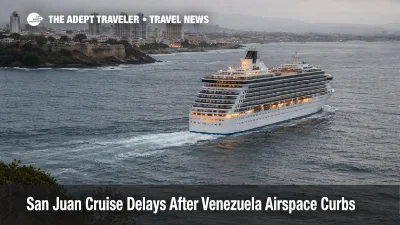
Windstar Caribbean Cruise Embarkation Delays After Closures

Venezuela Airspace Curbs Disrupt Caribbean Flights
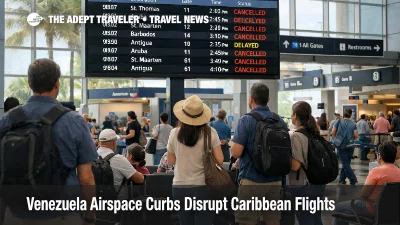
Sandals Caribbean Booking Credits Sale Ends Jan 2

Venezuela Airspace Warning Disrupts Caribbean Routes

Norwegian Cancels Curaçao Port Call on Caribbean Sailings
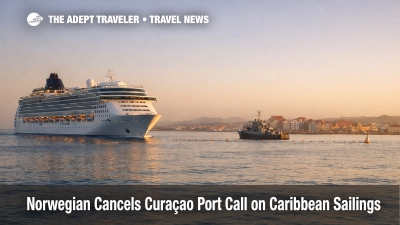
Carnival Firenze New York Cruises 2027 to 2028
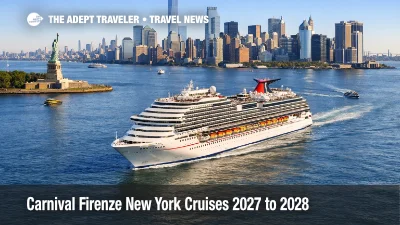
Venezuela Airspace Warning Forces Flight Reroutes

Venezuela Airspace Warning Reroutes Caribbean Flights
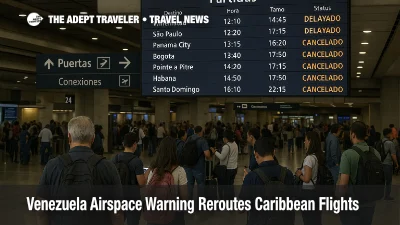
2028 World Cruise From Miami To Athens With Azamara
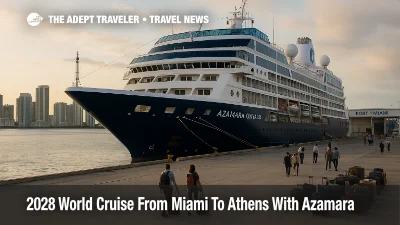
Melissa Cuts Jamaica Rooms, Shifts Dominican Winter Trips

Delta Locals Trip Planner Launches With Local Guides

Caribbean disturbance could become Tropical Storm Melissa

Curaçao visitor arrivals rise 8% in September 2025

Caribbean tropical disturbance may alter late-week cruises
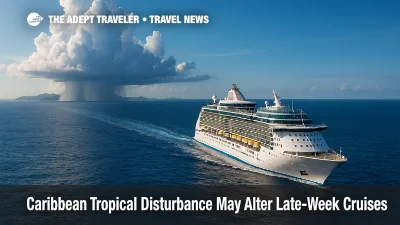
Royalton debuts Royalton Suites & Villas for Diamond Club

Carnival Venezia to homeport in Miami in May 2027
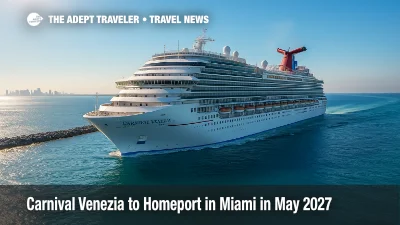
Hurricane Gabrielle brings dangerous surf; Narda turns away
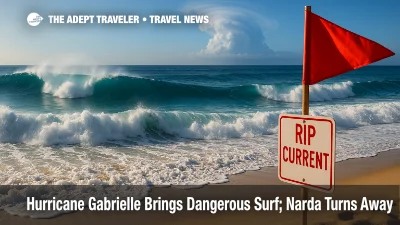
U.S. warships shift toward Venezuela, Caribbean travel impact explained

Tropical Storm Fernand swells near Bermuda, East Coast
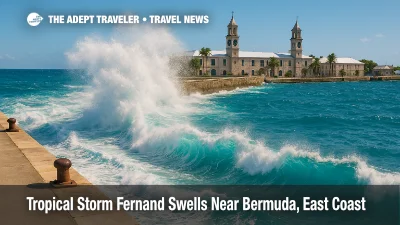
Caribbean travel demand surges, Aruba, D.R., Jamaica lead
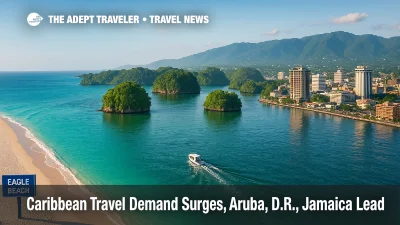
Cat-5 Hurricane Erin drives SXM, USVI cancellations

